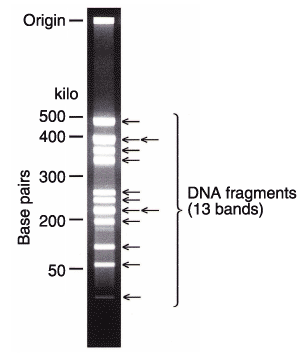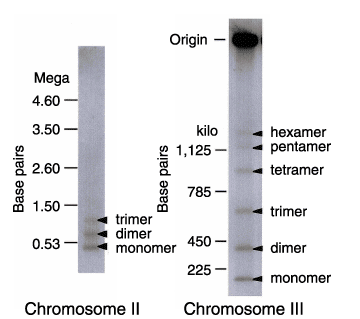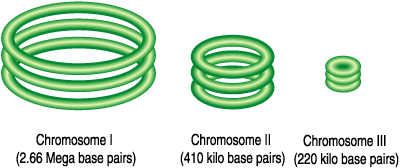A bacterium, Deinococcus radiodurans, had been listed in the Guinness Book of the Records as the "toughest bacterium in the world." Depending on its growth phase, the genome of this bacterium in a cell exists as a polyploid having four to ten sets of a single hereditary unit. To understand the radiation resistant mechanism of the bacterium, it is necessary to know the complexity of genomes. At first step, the chromosome constitution was investigated.
After digestion with an enzyme, which recognizes sites having a specific DNA sequence, chromosomes were separated into 13 DNA fragments (Fig. 5-17). By determining the neighbors of each fragment, reconstruc-tion of the chromosomes was achieved. Surprisingly, a genome set consisted of three circular chromosomes with different sizes. In general most of all bacteria have one circular chromosome in a cell, so it is clear that D. radiodurans has a unique chromosome constitution.
Furthermore, to know whether ten sets of three chromosomes exist independently in cells or not, the chromosomes were separated without digestion. Obviously, each chromo-some was organized into multimers (in the case of chromosome III; monomer to hexamer), as shown in Fig. 5-18. Since no bacterium possessing multimeric chromosomes has been known to date, this formation of multimeric chromosomes is supposed to be closely related to the radiation resistance in this bacterium. A model of the chromosome structure was proposed to explain the radiation resistance in terms of multimer formation (Fig. 5-19). If chromosomes are close together like the model, it is possible to elucidate the effective DNA repair mechanism because DNA lesions caused by irradiation and so on, can be repaired easily using a non-injured region of the chromosomes.
The reason why D. radiodurans is resistant to radiation has been thought to be due to effective DNA repair enzymes. However, we think, that the multimer formation of chromosomes is also important, because it allows the repair enzymes to work more effectively. |


